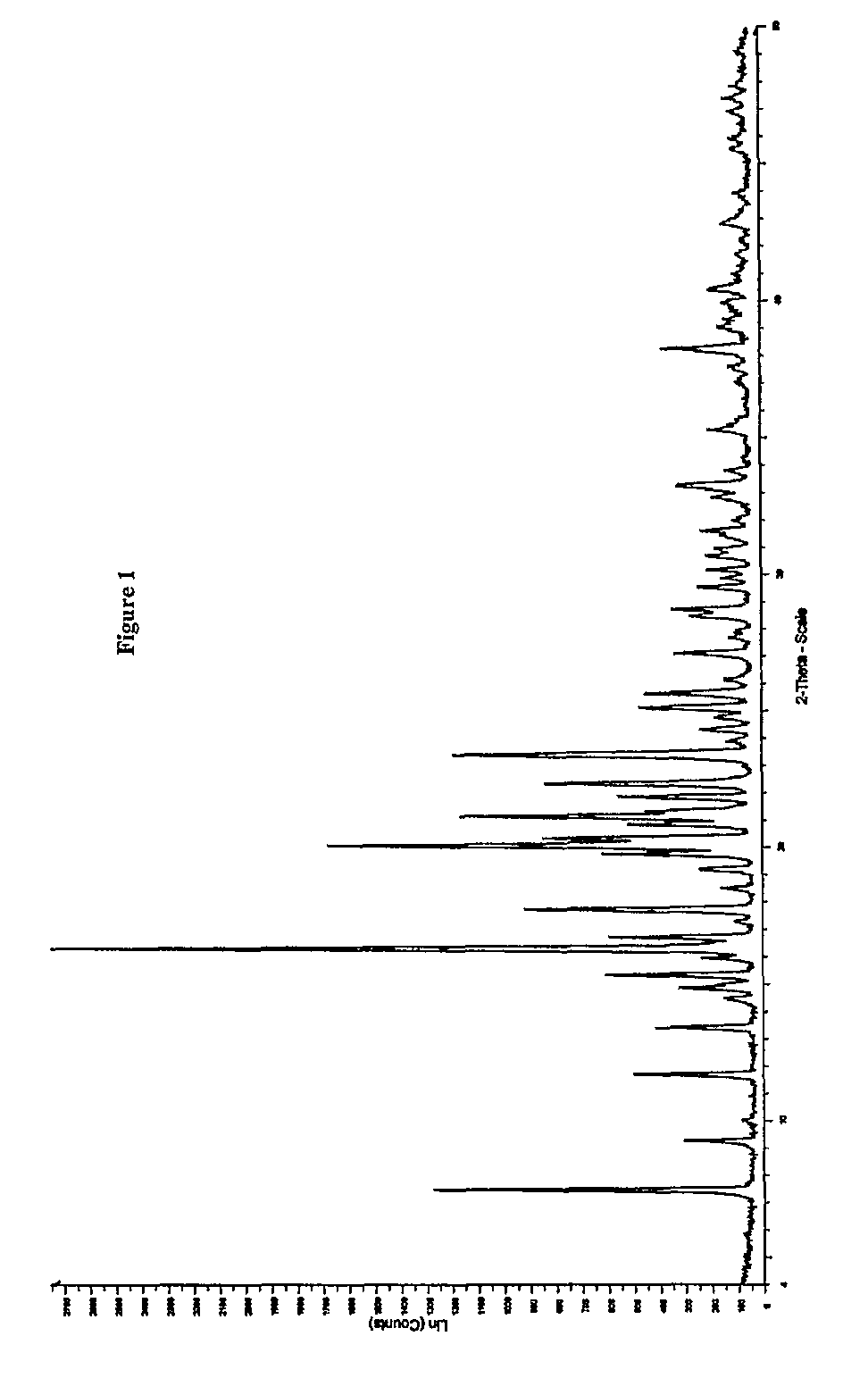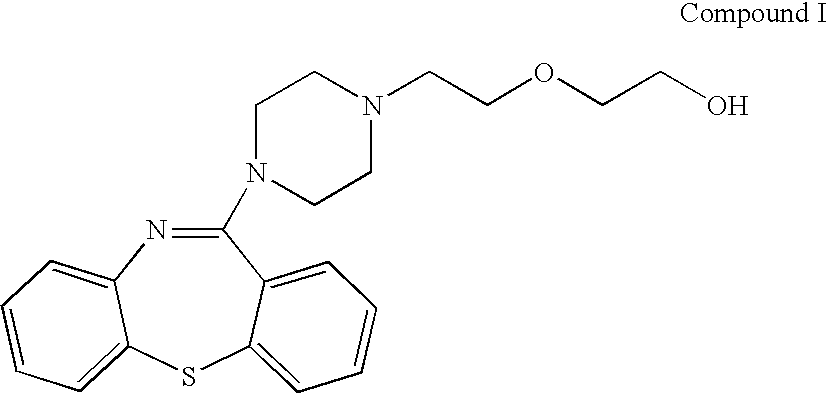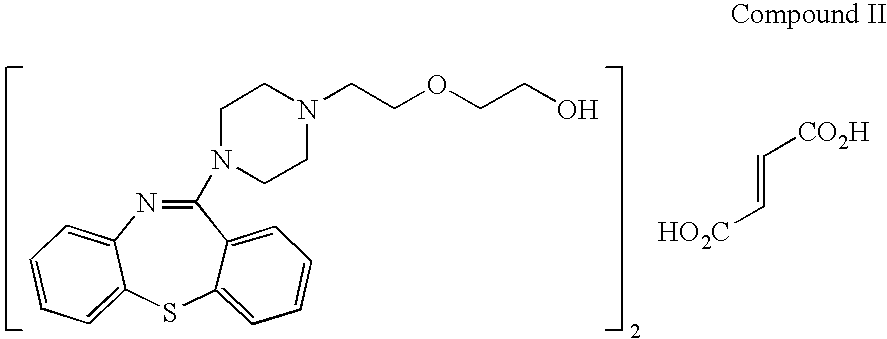Process for preparing quetiapine and quetiapine fumarate
a technology of quetiapine and fumarate, which is applied in the field of process for preparing quetiapine and quetiapine fumarate, can solve the problems of disubstituted anilines, high toxic and environmental hazards, and not easy to achieve economic benefits, and reduce reaction and reflux times.
- Summary
- Abstract
- Description
- Claims
- Application Information
AI Technical Summary
Benefits of technology
Problems solved by technology
Method used
Image
Examples
specific examples
[0052]The following examples are for illustrative purposes only and are not intended, nor should they be interpreted to, limit the scope of the invention.
[0053]General Experimental Conditions:
[0054]i. HPLC Method
[0055]Chromatographic separation was carried out in a Symmetry C8, 5 μm, 25 cm×4.6 mm I.D. column at room temperature (˜20-25° C.).
[0056]The mobile phase was prepared by mixing 700 volumes of 50 mM HClO4 (pH˜2.5, adjusted with 50% KOH) with 300 volumes of acetonitrile. The solution was then mixed and filtered through 0.22 μm nylon filter under vacuum.
[0057]The chromatograph was equipped with a 210 nm detector and the flow rate was 1.5 mL per minute. Test samples (˜20 μL) were prepared by dissolving a sufficient quantity of sample in order to obtain a 1 mg per mL concentration in the mobile phase.
[0058]ii. Particle Size Measurements and Distribution
[0059]The particle size for quetiapine fumarate was measured using a Malvern Mastersizer S particle size analyzer with an MS1 Sma...
example 1
Preparation of Quetiapine Fumarate
Step 1: Formation of Compound IV (11-chloro-dibenzo[b,f][1,4]thiazepine)
[0070]Dibenzothiazepinone (Compound III, 4.1 Kg, 18.04 mol) was combined with 19.2 Kg (22.33 L) of xylene in a suitable reactor. To the solution was added 2.07 Kg (13.50 mol, 1.26 L) of phosphorus oxychloride followed by 1.13 Kg (11.17 mol, 1.55 L) of triethylamine. The molar ratio of Compound III to phosphorous oxychloride to triethylamine to xylene is approximately 1 mol:0.7483 mol:0.6192 mol:1.2378 L. The initial addition of the triethylamine causes a mildly exothermic reaction and gas emission. Thus, during the addition of each of the components, care was taken to maintain the temperature of the reaction at approximately room temperature (˜20-25° C.).
[0071]After combining the reactants, the reactor was heated to reflux (approximately 140° C.) with continuous stirring and maintained at that temperature for 4 hours. Thereafter, the reactor contents were cooled to room temperat...
example 2
Preparation of Quetiapine Fumarate
Step 1: Formation of Compound IV (11-chloro-dibenzo[b,f][1,4]thiazepine)
[0079]Dibenzothiazepinone (Compound III, 100 g, 0.440 mol) was combined with 600 mL of xylene in 2 L flask kept at room temperature under a nitrogen atmosphere. To the solution was added 50.60 g (0.330 mol, 30.82 mL) of phosphorus oxychloride followed by 27.60 g (0.273 mol, 37.81 mL) of triethylamine. The molar ratio of Compound III to phosphorous oxychloride to triethylamine to xylene is 1 mol:0.75 mol:0.6205 mol:1.363 L. The initial addition of the triethylamine causes a mildly exothermic reaction and gas emission. Thus, during the addition of each of the components, care was taken to maintain the temperature of the reaction at approximately room temperature (˜20-25° C.).
[0080]After combining the reactants, the resulting white suspension was heated to approximately 140° C. with continuous stirring and maintained at that temperature for approximately 9.5 hours. Thereafter, the ...
PUM
| Property | Measurement | Unit |
|---|---|---|
| temperature | aaaaa | aaaaa |
| temperature | aaaaa | aaaaa |
| temperature | aaaaa | aaaaa |
Abstract
Description
Claims
Application Information
 Login to View More
Login to View More - R&D
- Intellectual Property
- Life Sciences
- Materials
- Tech Scout
- Unparalleled Data Quality
- Higher Quality Content
- 60% Fewer Hallucinations
Browse by: Latest US Patents, China's latest patents, Technical Efficacy Thesaurus, Application Domain, Technology Topic, Popular Technical Reports.
© 2025 PatSnap. All rights reserved.Legal|Privacy policy|Modern Slavery Act Transparency Statement|Sitemap|About US| Contact US: help@patsnap.com



